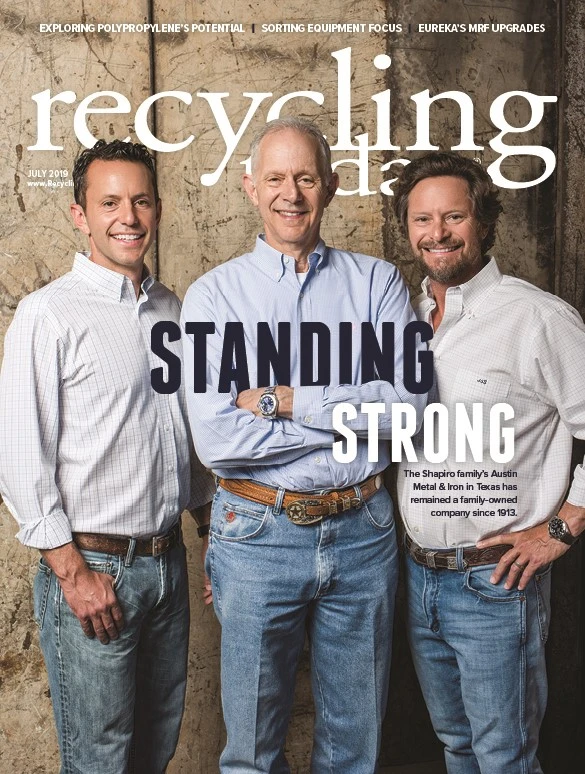About five years ago, GDB International, New Brunswick, New Jersey, noticed a jump in the amount of material it was processing out of its corporate facility. Sunil Bagaria, president and co-owner of GDB International, says single-ram vertical balers were not able to bale materials quick enough to meet the growing demands from customers.
“We were getting new contracts, acquiring more customers,” Bagaria says. “We were handling much more tonnage, hence the need for a new baler. We needed something big and effective.”
The company also needed a versatile baler. GDB primarily focuses on plastics, but it also processes various paper grades and several types of nonferrous metals.

“We are baling plastics, cardboard, loose paper, metal, aluminum cans, stainless steel,” Bagaria says. “We are baling a broad range of commodities. We didn’t want to install a baler for paper, a different baler for metal. If the same baler does the job, you just make one investment.”
After looking at several options and visiting other recycling facilities, GDB decided to install an American Baler machine—a model W721 two-ram horizontal baler. Brad Harmon, vice president of sales at Recycling Equipment Corp., Lansdale, Pennsylvania, says Recycling Equipment Corp. helped to install the two-ram horizontal baler at GDB’s New Brunswick facility.
Harmon says the new machine was able to increase the amount of materials the facility was baling. Prior to adding the two-ram horizontal baler, the facility baled only 30 to 40 bales a day. With the new baler, GDB can bale up to 200 bales a day.
“We bought a machine that was bigger than what we required at that time, so if we grew, we would not need to scramble and buy another machine,” Bagaria adds. “That was a nice decision. Volume increased in the next year and we didn’t have to change the machine.”
Additionally, Bagaria says most bales are coming out heavier than anticipated to ensure the company can maximize the weight in containers. The versatility of the model W721 allows for quick adjustment in ram pressure needed to bale different types of material.
“The machine can just keep baling away,” Harmon adds. “It can change commodity grades on the fly. They finish one bale and change immediately to another commodity with the push of a button. So, rather than trying to buy multiple pieces of equipment to do the job, it’s easier to buy one baler.”
Rely on experience
A few years ago, GDB expanded its operations into Wisconsin. Bagaria says the company had a growing supplier and customer base in that area. “To service [customers] effectively, we had to have a local operation,” he says. “The cost of trucking and transportation to New Jersey was increasingly becoming prohibitive; hence we had to set up an operation in Wisconsin.”
In 2017, GDB opened a facility in Neenah, Wisconsin. The facility processes mostly plastic and paper commodities. “We handle a lot more paper in Wisconsin than we do here in New Jersey,” Bagaria says.
“We were handling much more tonnage, hence the need for a new baler. We needed something big and effective.” – Sunil Bagaria, president, GDB International
Based on GDB’s experience with American Baler’s model W721 two-ram horizontal baler, the company installed the same machine at the Neenah facility in 2018.
“We didn’t spend too much time looking for another baler,” Bagaria says. “Ultimately, we just went with our experience. Our experience in New Jersey said we must put the same machine in Wisconsin.”
“When [GDB] gathered quotes, information and due diligence, they came back to a comfort level with Recycling Equipment Corp. and American Baler on reliability, ease of use and parts availability,” Harmon adds. “They reflected on their first purchase and were comfortable with a second purchase.”
Bagaria says GDB has plans to expand to additional facilities in the near-term future.
Sponsored Content
Labor that Works
With 25 years of experience, Leadpoint delivers cost-effective workforce solutions tailored to your needs. We handle the recruiting, hiring, training, and onboarding to deliver stable, productive, and safety-focused teams. Our commitment to safety and quality ensures peace of mind with a reliable workforce that helps you achieve your goals.
INTEGRITY | QUALITY | RELIABLITY| VALUE
800.843.7512
Get curated news on YOUR industry.
Enter your email to receive our newsletters.

Explore the July 2019 Issue
Check out more from this issue and find your next story to read.
Latest from Recycling Today
- Ball links up with JV partner for aluminum cup operations
- Electrolux commits to recycled content
- Duesenfeld system targets battery cell scrap
- Hyundai says it will make steel in the US
- APR announces Recycling Leadership Award winners
- Glass Half Full opens glass recycling facility in Louisiana
- AmpUp partners with Roundtrip EV
- Global Recycling Day event supports Pittsburgh school's recycling efforts







